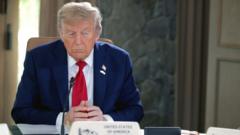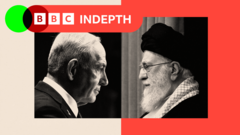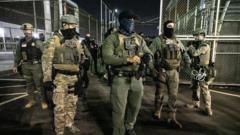Following a severe escalation in conflict over Kashmir, U.S. President Trump has brokered a cease-fire agreement between India and Pakistan, bringing a temporary halt to hostilities that included drone warfare. Official announcements suggested direct negotiations between the two countries, but U.S. involvement was also noted, underlining continued international interest in the volatile region.
Trump Facilitates Cease-fire Amid Intensified India-Pakistan Conflict

Trump Facilitates Cease-fire Amid Intensified India-Pakistan Conflict
After four days of intense military engagement, U.S. President Trump announces a cease-fire between India and Pakistan, with both nations confirming the halt of hostilities on May 10, 2025.
On May 10, 2025, officials from India and Pakistan confirmed a cease-fire after four days of the most intense military confrontation in decades, primarily centered around the contested territory of Kashmir. U.S. President Donald Trump took to social media to announce that both nations agreed to a "FULL AND IMMEDIATE CEASEFIRE" after a long night of discussions mediated by the United States.
Immediate approval came from both former rivals, although specifics surrounding the cease-fire agreement and the extent of external mediation remain disputed. India's foreign ministry mentioned that negotiations occurred directly between the two nations, denying the U.S.'s decisive role. In the days leading up to the cease-fire, tensions had significantly escalated, with combat focused on aerial strikes and drone usage, marking a new phase in the longstanding conflict.
The escalation started after a deadly attack on Indian tourists in Kashmir on April 22, which India blamed on Pakistan-based militants. Following retaliatory airstrikes and continuing military exchanges, the U.S., alongside other nations, exerted diplomatic pressure on both sides. Despite the forged cease-fire, skepticism remains regarding whether this agreement will remain stable, especially given the series of military and diplomatic confrontations that preceded it.
Several nations, notably Saudi Arabia and the UAE, attempted to mediate between the two nuclear-armed neighbors, fearing a full-scale war. The conflict saw both sides deploy large numbers of drones, which analysts warn could change future warfare in the region. The cease-fire signals a pause, but analysts are concerned that deep-seated issues regarding Kashmir remain unresolved.
In the context of this new agreement, U.S. Secretary of State Marco Rubio and Vice President JD Vance engaged in shuttle diplomacy, communicating with leadership from both countries rapidly to negotiate peace. Continued military readiness on both sides suggests a tenuous calm, with potential for discussions to resume addressing other long-standing issues between the two countries.
This cease-fire has allowed for the reopening of airspace over Pakistan—previously closed due to military hostilities—which could ease travel disruptions caused by the conflict. However, the path forward remains uncertain, as both India and Pakistan have long histories of conflict around territorial disputes and military engagement.
As international observers maintain focus on the subcontinent, analysts note that the future stability of the cease-fire hinges on both countries' willingness to constructively engage in dialogue, with Kashmir continuing to be a critical flashpoint for the region.
Immediate approval came from both former rivals, although specifics surrounding the cease-fire agreement and the extent of external mediation remain disputed. India's foreign ministry mentioned that negotiations occurred directly between the two nations, denying the U.S.'s decisive role. In the days leading up to the cease-fire, tensions had significantly escalated, with combat focused on aerial strikes and drone usage, marking a new phase in the longstanding conflict.
The escalation started after a deadly attack on Indian tourists in Kashmir on April 22, which India blamed on Pakistan-based militants. Following retaliatory airstrikes and continuing military exchanges, the U.S., alongside other nations, exerted diplomatic pressure on both sides. Despite the forged cease-fire, skepticism remains regarding whether this agreement will remain stable, especially given the series of military and diplomatic confrontations that preceded it.
Several nations, notably Saudi Arabia and the UAE, attempted to mediate between the two nuclear-armed neighbors, fearing a full-scale war. The conflict saw both sides deploy large numbers of drones, which analysts warn could change future warfare in the region. The cease-fire signals a pause, but analysts are concerned that deep-seated issues regarding Kashmir remain unresolved.
In the context of this new agreement, U.S. Secretary of State Marco Rubio and Vice President JD Vance engaged in shuttle diplomacy, communicating with leadership from both countries rapidly to negotiate peace. Continued military readiness on both sides suggests a tenuous calm, with potential for discussions to resume addressing other long-standing issues between the two countries.
This cease-fire has allowed for the reopening of airspace over Pakistan—previously closed due to military hostilities—which could ease travel disruptions caused by the conflict. However, the path forward remains uncertain, as both India and Pakistan have long histories of conflict around territorial disputes and military engagement.
As international observers maintain focus on the subcontinent, analysts note that the future stability of the cease-fire hinges on both countries' willingness to constructively engage in dialogue, with Kashmir continuing to be a critical flashpoint for the region.






















